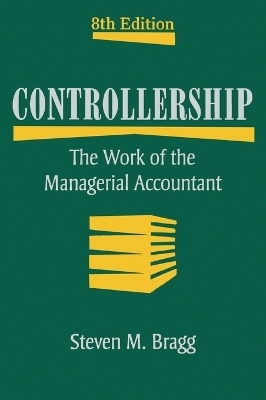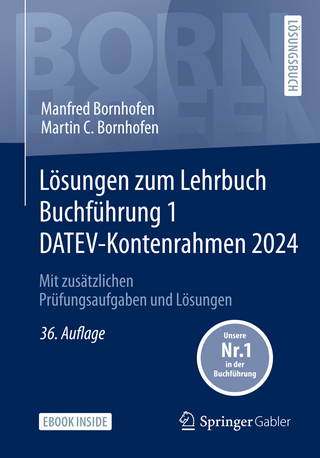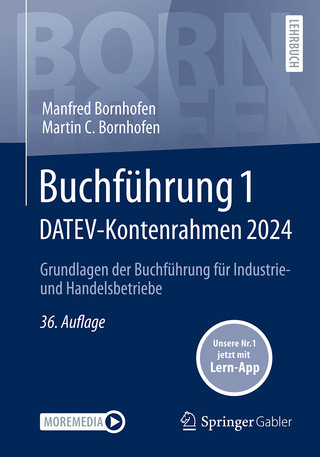
Controllership
John Wiley & Sons Inc (Verlag)
978-0-470-48198-1 (ISBN)
Today's controllers are no longer seen as technicians who process transactions; they are now seen as business executives with a wide-ranging knowledge of total business operations, best practices, and corporate strategy. Providing a comprehensive overview of the roles and responsibilities of controllers in today's environment, this Eighth Edition of Controllership continues to provide controllers and vice presidents of finance with all aspects of management accounting from the controller's perspective, including internal control, profit planning, cost control, inventory, and financial disclosure.
Steven M. Bragg, CPA, CMA, CIA, CPIM, (Centennial, CO) has been the chief financial officer or controller of four companies, as well as a consulting manager at Ernst & Young and auditor at Deloitte. He is the author of over 25 books primarily targeted toward controllers and their needs. Bragg received a master's degree in finance from Bentley College, an MBA from Babson College, and a bachelor's degree in economics from the University of Maine.
About the Author xvii
Preface xix
Part I the Broad Management Aspects of Controllership 1
Chapter 1 Accounting in the Corporation 3
Tasks of the Accounting Function 3
Role of the Accounting Function 5
Role of the Controller 6
Impact of Ethics on the Accounting Role 7
Evolving Role of Accounting 10
Chapter 2 Controller’s Responsibilities 13
Variations on the Title 13
Planning Function 14
Control Function 15
Reporting Function 15
Accounting Function 16
Additional Controller Functions in Smaller Companies 17
Controller’s Job Description 19
Relationship of the Controller to the Chief Financial Officer 21
Chapter 3 Cost Accounting and Costing Systems 23
Purpose of Cost Accounting Information 23
Input: Data Collection Systems 24
Processing: Data Summarization Systems 27
Processing: Job Costing 29
Processing: Process Costing 34
Processing: Standard Costing 38
Processing: Direct Costing 40
Processing: Throughput Costing 43
Processing: Activity-Based Costing 48
Processing: Target Costing 50
Outputs: Cost Variances 52
Chapter 4 Ratio and Trend Analysis 57
How to Use Ratios and Trends 57
A Caveat 58
Measures for Profitability 60
Measures for the Balance Sheet 62
Measures for Growth 66
Measures for Cash Flow 68
Measures for Nonfinancial Performance 70
Interrelationship of Ratios 85
Setting Up a System of Ratios and Trend Analyses 85
Chapter 5 Internal Control Systems 89
Objectives 89
Responsibility for Internal Controls 90
Examples of Internal Controls 92
When to Eliminate Controls 102
Types of Fraud 104
Preventing Fraud 105
How to Deal with a Fraud Situation 109
Chapter 6 Internal Audit Function 113
Reporting Relationships 113
Role of the Audit Committee 116
Internal Audit Objectives 117
Internal Audit Activities 119
Chapter 7 Recruiting, Training, and Supervision 123
Recruiting Sources 123
Factors to Consider when Recruiting 125
Factors to Consider When Promoting 127
Importance of Reduced Turnover 128
Importance of Developing Career Plans for Employees 132
How to Motivate Employees 134
Chapter 8 Controller’s Role in Investor Relations 137
Objectives of the Investor Relations Function 137
Communication Vehicles for Investor Relations 138
Investor Relations Message Recipients 138
Information Needs of the Financial Analyst 139
Information Needs of Other Groups 141
Providing Guidance 141
Forward-Looking Statements 144
Organization Structure for Investor Relations 146
Role of the Controller and Other Principals 147
Part II the Planning Function of Controllership 151
Chapter 9
Business Plans and Planning: Interrelationship of Plans, Strategic Planning 153
Business Planning Defined 153
Framework for Business Planning 154
Time as Related to Planning 154
Planning Period: How Long Is “Long Range”? 155
System of Plans 156
Strategic Plan: An Overview 156
Corporate Development Plan 157
Operations Plan 158
Basic Elements in Any Plan 158
Planning Process 159
Plan Frequency 161
Plan Guidelines 162
Supplemental Planning: Alternative Scenarios 162
Planning Timetable or Schedule 163
Strategic Planning: An In-Depth Review 163
Environmental Analysis 165
Critical Success Factors 167
Business Mission or Purpose 168
Long-Range Business Planning Objectives 170
Developing Strategies 174
Strategies and the Planning Period 177
Role of the Controller 177
Chapter 10
Financial Impact of the Strategic Plan: Long-Range Financial Plan 181
Key Elements of a Strategic Plan 181
Capital Investments 182
Risk Analysis 183
Objectives of the Long-Range Financial Plan 184
Consolidation and Testing Process 185
Illustrative Financial Exhibits in the Plan Presentation 186
Role of the Controller 193
Chapter 11 Profit Planning: Annual Plan 201
Purpose of Budgeting 201
Planning Benefits 202
Coordination Benefits 203
Control Benefits 205
Problems with the Annual Plan 205
Annual Planning Cycle: Illustrative 206
Supportive Financial Statements and Budgets 208
Sales Budget 209
Production Budget 210
Purchases Budget 210
Direct Labor Budget 211
Manufacturing Expense Budget 211
Inventory Budget 212
Operating Expense Budget 212
Capital Expenditures Budget 213
Cost of Goods Sold 213
Statement of Estimated Income and Expense 214
Cash Budget 214
Statement of Estimated Financial Condition 216
Approval of Budget 218
Linking the Bonus Plan to the Budget 218
Controller’s Role: A Key Player 219
Management Approval of the Plan 223
Chapter 12 Profit Planning: Supporting Financial Analysis for the Annual Plan 225
General Comments on the Cost-Volume-Profit Relationship 225
Breakeven Chart 226
Changes in Sales Revenue 228
Changes in Sales Mixture 228
Changes in Sales Price 230
Changes in Costs 231
Analysis by Product 232
Application of Cost-Volume-Profit Analysis 235
Selecting the Most Profitable Products 236
Increased Sales Volume to Offset Reduced Selling Prices 236
Most Profitable Use of Scarce Materials 237
Advisability of Plant Expansion 238
Some Practical Generalizations 239
Program Evaluation Using Discounted Cash Flow 240
Financial Analysis of Unacceptable Operating Results 243
More Sophisticated Analyses 258
Chapter 13 Taxation Planning 259
Accumulated Earnings Tax 260
Cash Method of Accounting 261
Inventory Valuation 262
Mergers and Acquisitions 262
Net Operating Loss Carryforwards 263
Nexus 264
Passive Activity Losses 265
Project Costing 266
Property Taxes 267
S Corporation 267
Sales and Use Taxes 268
Transfer Pricing 269
Unemployment Taxes 271
Management of the Taxation Function 272
Part III Planning and Controlling Operations 275
Chapter 14 General Discussion of Standards 277
Definition of Standards 277
Advantages of Standards 278
Relationship of Entity Goals to Performance Standards 280
Types of Standards Needed 281
Trend to More Comprehensive Performance Measures 285
Benchmarking 287
Setting the Standards 289
Use of Standards for Control 291
Procedure for Revising Standards 293
Chapter 15 Planning and Control of Sales 295
Sales Management Concerns 295
Controller’s Assistive Role in Sales Management Problems 296
Controller’s Independent Role in the Planning and Control of Sales 299
Sales Analysis 300
Sales Planning: Basis of All Business Plans 304
Steps in Developing the Near-Term Sales Plan/Budget 305
Methods of Determining the Sales Level 308
Useful Sources of Forecasting Information 311
Forecasting the Business Cycle 312
Sales Standards 318
Sales Reports 322
Product Pricing: Policy and Procedure 328
Chapter 16 Planning and Control of Marketing Expenses 339
Definition 339
Factors Increasing the Difficulty of Cost Control 341
Marketing Expense Analysis 341
Types of Analyses 342
Planning Marketing Expenses 353
Special Comments on Advertising and Sales Promotion Expense 354
Marketing Expense Standards 360
Chapter 17 Planning and Control of Manufacturing Costs: Direct Material and Direct Labor 367
Direct Material Costs: Planning and Control 372
Labor Costs: Planning and Control 379
Chapter 18 Planning and Control of Manufacturing Costs: Manufacturing Expenses 389
Proper Departmentalization of Expenses 389
Variations in Cost Based on Fixed and Variable Costs 390
Variations in Cost Based on Direct Labor 392
Variations in Cost Based on Batch Size 394
Variations in Cost Based on Overhead 396
Variations in Cost Based on Time 398
Cost Estimation Methods 399
Normal Activity 404
Allocation of Indirect Production Costs 405
Budgetary Planning and Control of Manufacturing Expenses 407
Securing Control of Overhead 409
Control with Throughput Analysis 415
Role of the Controller 416
Chapter 19 Planning and Control of Research and Development Expenses 425
R&D Activities in Relation to Corporate Objectives 425
Organization for the R&D Financial Functions 425
Elements of R&D Costs 426
Role of the Financial Executive in R&D 429
Determining the Total R&D Budget 429
Establishing the R&D Operating Budgets 430
Detailed Budgeting Procedure 438
Other Control Methods 438
Effectiveness of R&D Effort 442
Chapter 20 Financial Planning and Control in a Service Company 447
Data Classification 447
Cost Accounting in a Service Organization 449
Planning System 454
Strategic Planning 459
Chapter 21 Planning and Control of General and Administrative Expenses 461
Components of G&A Expense 461
Control over G&A Expenses 462
Reducing G&A Expenses 468
Spend Management Systems 473
Budgeting G&A Expenses 474
Chapter 22 Payroll 477
Improving the Payroll Process 479
Compensation 485
Federal Income Taxes 489
Social Security Taxes 491
Medicare Tax 491
State Income Taxes 491
Payroll Taxes for Employees Working Abroad 492
Remitting Federal Taxes 492
Payroll Deductions for Child Support 494
Payroll Deductions for Unpaid Taxes 495
Unemployment Insurance 496
Part IV Planning and Control of the Balance Sheet 499
Chapter 23 Planning and Control of Cash and Short-Term Investments 501
Objectives of Cash Planning and Control 501
Duties of the Controller versus the Treasurer 501
The Cash Forecast 502
Cash Collections 514
Cash Disbursements 520
Internal Control 521
Reports on Cash 524
Cash Flow Ratio Analysis 526
Variations in Cash Requirements by Industry 528
Investment of Short-Term Funds 529
Chapter 24 Planning and Control of Customer Credit and Receivables 533
Credit Procedures and Systems 533
Collection Procedures and Systems 542
Measurement of Accounts Receivable 548
The Bad Debt Forecast 549
Budgeting for Accounts Receivable Balances 550
Chapter 25 Planning and Control of Inventories 553
Costs and Benefits of Carrying Inventory 553
Role of the Controller 555
Material Requirements Planning Systems 557
JIT Manufacturing Systems 558
Inventory Purchasing 561
Production Issues Impacting Inventory 563
Inventory Quantity Management 565
Obsolete Inventory 567
Inventory Cutoff 570
Budgeting for Raw Materials 572
Budgeting for Work-in-Process 577
Budgeting for Finished Goods 578
Significance of Proper Inventory Valuation 582
Selection of the Cost Base 582
Chapter 26 Accounting and Reporting for Selected Investments and Employee Benefit Plans 585
Improving the Investment Decision Process 585
Role of the Controller 586
Accounting Records for Selected Investments 587
Financial Reports on Selected Investments 587
Accounting and Disclosure Requirements and Practices for Employee Benefit Plans 590
Chapter 27 Planning and Control of Plant and Equipment or Capital Assets 601
Controller’s Responsibility 601
Capital Budgeting Process 603
Information Supporting Capital Expenditure Proposals 604
Methods of Evaluating Projects 605
Payback Method 606
Operators’ Method 607
Accountants’ Method 608
Discounted Cash Flow Methods 609
Cash Flow Modeling Issues 614
Hurdle Rates 615
Cost of Capital—A Hurdle Rate 616
Throughput Method 617
Classifying and Ranking Proposed Capital Projects 620
Problems with the Capital Budget Approval Process 621
Using Expected Commercial Value for Project Ranking 622
Board of Directors’ Approval 624
Project Authorization 628
Accounting Control of the Project 630
Postproject Appraisals or Audits 630
Other Aspects of Capital Expenditures 632
Chapter 28 Management of Liabilities 637
Objectives of Liability Management 637
Direct Liabilities 638
Planning the Current Liabilities 639
Standards to Measure and Control Current Liabilities 642
Corrective Action 644
Some Benefits from Debt Incurrence 644
Standards for Debt Capacity 645
Leverage 648
Managing Liabilities: Some Practical Steps 649
Management of Accounts Payable 652
Accounting Reports on Liabilities 656
Internal Controls 656
Chapter 29 Management of Shareholders’ Equity 659
Role of the Controller 659
Growth of Equity as a Source of Capital 660
Return on Equity as Related to Growth in Earnings per Share 661
Growth in Earnings per Share 661
Cost of Capital 663
Components of Cost of Capital 664
Calculating the Cost of Debt 665
Calculating the Cost of Equity 666
Calculating the Weighted Cost of Capital 669
Dividend Policy 670
Other Transactions Affecting Shareholders’ Equity 672
Long-Term Equity Planning 673
Short-Term Plan for Shareholders’ Equity 678
Other Considerations 680
Part V Financial and Related Reports 683
Chapter 30 Internal Management Reports 685
Rules of Reporting 685
Status Reports 688
Margin Reports 690
Cash Reports 694
Capacity Reports 695
Sales and Expense Reports 696
Payroll Reports 698
Graphical Report Layouts 703
Chapter 31 External Reporting 705
Purpose of the Annual Report to Shareholders 705
Controller and the Annual Report 706
General Contents of the Annual Report 706
Importance of Form 709
Other Reports to Shareholders 711
Disclosure Issues 712
SEC Forms 713
Contents xv
Part VI Some Administrative and Special Aspects of the Con- Troller’s Department 719
Chapter 32 Mergers and Acquisitions 721
Acquisition Strategy 721
The Acquisition Process 723
Locating Acquisition Targets 726
Due Diligence 729
Valuing the Target 739
Legal Documents 743
Acquisition Integration 753
Types of Acquisitions 760
Chapter 33 The Reporting Period and How to Close It 763
Selecting the Fiscal Year 763
Selecting the Number of Interim Reporting Periods 764
Reasons for Accelerating the Closing Period 766
How to Achieve a Fast Close 766
Chapter 34 Inventory Tracking 781
Differences between Perpetual and Periodic Inventory Systems 781
Setting Up a Perpetual Inventory System 783
Auditing and Measuring a Perpetual Inventory System 787
Physical Inventory Procedure 788
Physical Inventory Complications: The Cutoff 791
Reconciling Inventory Variances 792
How to Avoid the Inventory Tracking Problem 794
Chapter 35 Tax Records and Procedures 797
Tax Organization 798
Centralized Tax Department 798
Functions Of the Tax Manager 800
Tax Communications 801
Tax Records in General 801
Tax Calendar 802
Tax Information Records 802
Tax Working Papers and Files 805
Internal Revenue Code and Record Requirements 805
Proper Classification of Accounts 805
Other Taxes 806
Income Taxes and Business Planning 806
Special Tax Reports 806
Index 807
| Erscheint lt. Verlag | 11.9.2009 |
|---|---|
| Zusatzinfo | Exhibits: 254 B&W, 0 Color |
| Verlagsort | New York |
| Sprache | englisch |
| Maße | 187 x 256 mm |
| Gewicht | 1542 g |
| Themenwelt | Wirtschaft ► Betriebswirtschaft / Management ► Rechnungswesen / Bilanzen |
| ISBN-10 | 0-470-48198-6 / 0470481986 |
| ISBN-13 | 978-0-470-48198-1 / 9780470481981 |
| Zustand | Neuware |
| Informationen gemäß Produktsicherheitsverordnung (GPSR) | |
| Haben Sie eine Frage zum Produkt? |
aus dem Bereich


